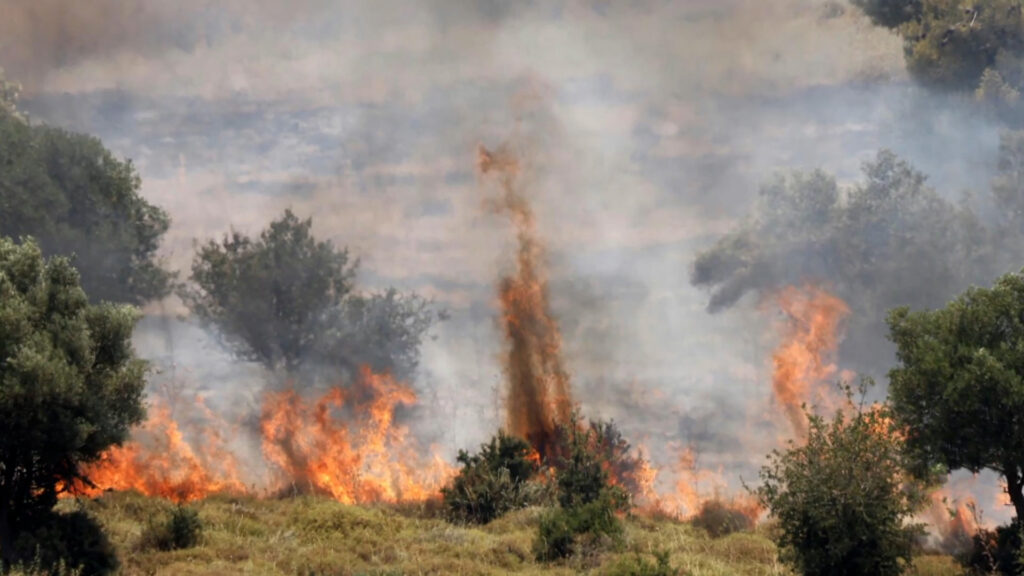Social media platforms reacted widely to the largest missile attack carried out by Lebanese Hezbollah on northern Israel, since the outbreak of the Israeli war on the Gaza Strip on October 7th.
Hezbollah’s missile attack came in response to the assassination by the Israeli occupation army of Talib Sami Abdullah, one of the party’s most prominent military leaders, in a raid that targeted – two days ago – a house in the town of Joya in southern Lebanon.
The attack also came as a translation of the threats of Hezbollah Executive Council Chairman Hashem Safi al-Din during Talib’s funeral ceremony, where Israel promised that the response to the assassination would be in the field, and that it would be more severe, more violent, more quantitative and more qualitative.
Indeed, Hezbollah fired more than 215 rockets and shells from southern Lebanon at the regions of Galilee, the northern Jordan Valley, the Golan, the Shebaa Farms, and the Kfar Shuba Hills, according to the occupation army radio, which also said that the army’s defenses intercepted most of those missiles.
In turn, the party confirmed the targeting of 19 Israeli sites, the most important of which are the “Blasan” military industries factory, the headquarters of the Northern Corps Command, and the headquarters of the Air Operations Management Unit at Meron Base.
As a result, several new fires broke out in the forests in northern Israel, and while the Israeli Broadcasting Corporation said that 21 firefighting brigades and 8 aircraft were trying to put out the fires, Israeli newspapers confirmed that the fire had burned in about 30,000 square metres, and that it posed a danger to Israeli strategic installations.
Praise and demands for more
The “Shabakat” program – in its episode on (6/13/2024) – monitored some of the tweeters’ comments regarding the unprecedented missile attack by Hezbollah since the beginning of the “Al-Aqsa Flood” battle, which led to the outbreak of fires again in Israel.
In this context, Yahya Abu Zakaria commented on the developments of events, saying, “Widespread fires in northern occupied Palestine after Hezbollah targeted military sites with missiles and drones,” and added, “Once again, Hezbollah is disciplining the Zionists, blowing up the so-called Israeli deterrence force, and burning the settlements in the north.”
Ayoub expressed his hope that Hezbollah would expand the scope of targeting in Israel to include vital installations. He said, “I hope that Hezbollah will go beyond that and actually destroy the airports, then the ports, and then sabotage the land supply routes.”
In turn, Ahmed touched on Hezbollah’s missile arsenal, saying: “The past months have shown the extent of the power of precision weapons that Hezbollah has accumulated since the Second Lebanon War, and also its thoughtful arrangement of priorities in choosing its targets, first the military targets before the civilian ones.”
For his part, Abdel Sattar shed light on the performance of Israeli defenses in the face of Hezbollah missiles, and said in this context, “For the first time, Iron Dome failed to intercept several missiles launched from southern Lebanon, large fires broke out in northern Israel, and schools stopped in Safed.”
An account called “My Voice is Free” praised Hezbollah’s performance since the outbreak of the Israeli war on the Gaza Strip, and said, “For 250 days on the front of occupancy and support, with blood and fire, the men of Hezbollah stood with Gaza, its people, and its resistance. To that end, they made great sacrifices, and they remained steadfast.” The Lebanon front is on the Gaza front.”
It should be noted that Israel responded to Hezbollah’s attack by launching air strikes around the towns of Yater, Zibqin, Yaroun, Deir Saryan, and the Wadi Saluki area in southern Lebanon. Israeli artillery also bombed with incendiary shells the surroundings of the towns of Aita al-Shaab, al-Qawzah, Wadi Shihin, al-Jibain, and al-Adaysah.
Israeli media also published a video clip, showing soldiers from the occupation army using catapults to burn Lebanese lands with fireballs. Israeli Channel 12 indicated that the soldiers were deliberately starting fires with the aim of discovering and destroying Hezbollah sites.

